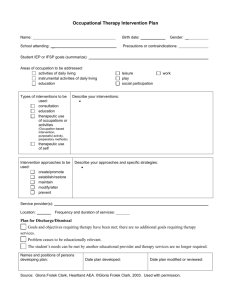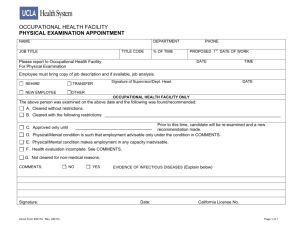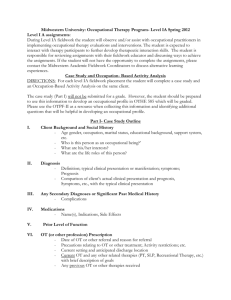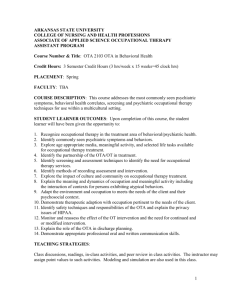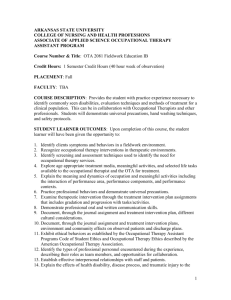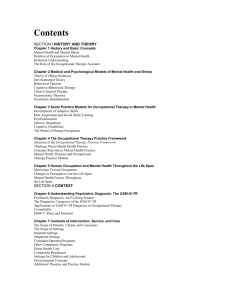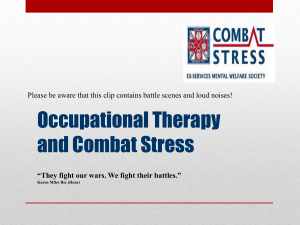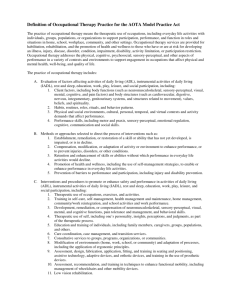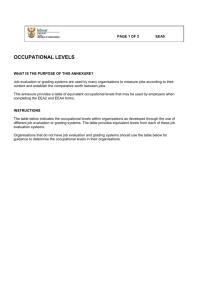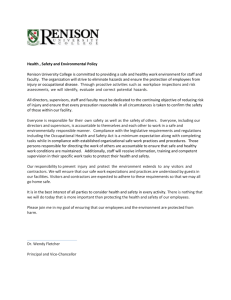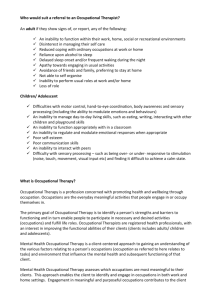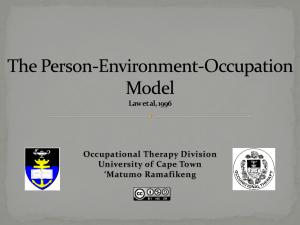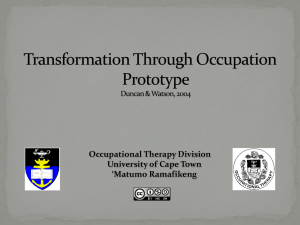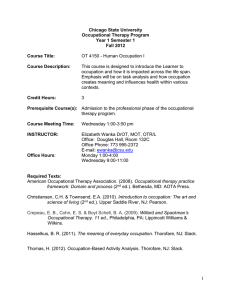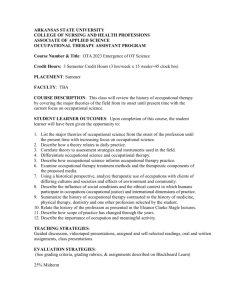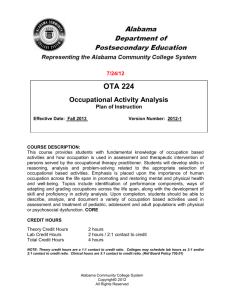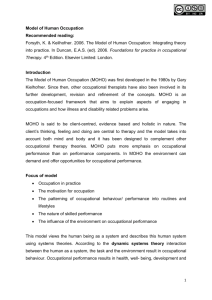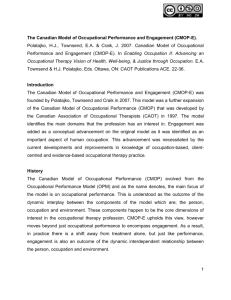ARKANSAS STATE UNIVERSITY COLLEGE OF NURSING AND
advertisement
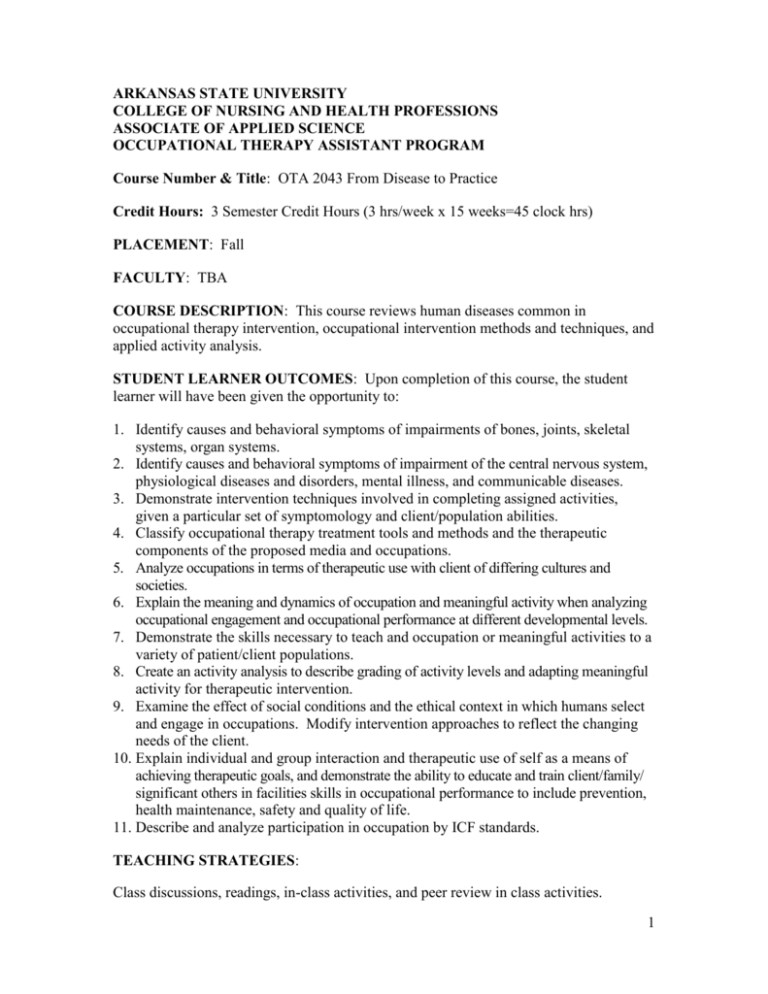
ARKANSAS STATE UNIVERSITY COLLEGE OF NURSING AND HEALTH PROFESSIONS ASSOCIATE OF APPLIED SCIENCE OCCUPATIONAL THERAPY ASSISTANT PROGRAM Course Number & Title: OTA 2043 From Disease to Practice Credit Hours: 3 Semester Credit Hours (3 hrs/week x 15 weeks=45 clock hrs) PLACEMENT: Fall FACULTY: TBA COURSE DESCRIPTION: This course reviews human diseases common in occupational therapy intervention, occupational intervention methods and techniques, and applied activity analysis. STUDENT LEARNER OUTCOMES: Upon completion of this course, the student learner will have been given the opportunity to: 1. Identify causes and behavioral symptoms of impairments of bones, joints, skeletal systems, organ systems. 2. Identify causes and behavioral symptoms of impairment of the central nervous system, physiological diseases and disorders, mental illness, and communicable diseases. 3. Demonstrate intervention techniques involved in completing assigned activities, given a particular set of symptomology and client/population abilities. 4. Classify occupational therapy treatment tools and methods and the therapeutic components of the proposed media and occupations. 5. Analyze occupations in terms of therapeutic use with client of differing cultures and societies. 6. Explain the meaning and dynamics of occupation and meaningful activity when analyzing occupational engagement and occupational performance at different developmental levels. 7. Demonstrate the skills necessary to teach and occupation or meaningful activities to a variety of patient/client populations. 8. Create an activity analysis to describe grading of activity levels and adapting meaningful activity for therapeutic intervention. 9. Examine the effect of social conditions and the ethical context in which humans select and engage in occupations. Modify intervention approaches to reflect the changing needs of the client. 10. Explain individual and group interaction and therapeutic use of self as a means of achieving therapeutic goals, and demonstrate the ability to educate and train client/family/ significant others in facilities skills in occupational performance to include prevention, health maintenance, safety and quality of life. 11. Describe and analyze participation in occupation by ICF standards. TEACHING STRATEGIES: Class discussions, readings, in-class activities, and peer review in class activities. 1 EVALUATION STRATEGIES: (See grading criteria, grading rubrics, & assignments described on Blackboard Learn) Each student will achieve competency in each skill covered in this class. Examination on Physical Diseases Examination on Mental Illness Examination across all diseases Activity Analysis Quality of Class Projects 20% 20% 20% 10% 30% REQUIRED TEXTS: Early, Mary Beth. (2013). Physical Dysfunction Practice Skills for the Occupational Therapy Assistant (3rd Edition) Mosby: New York. Baglole, T. (2006) Changing community based services: COTA Comprehensive Rehabilitation and Mental Health Services. Occupational Therapy NOW, September 2006, Volume 8.5 Tubbs, C., Drake, M. (2013). Crafts and Creative Media in Therapy. (4th Edition). Slack: Thorofare, NJ Tamparo, C.D., and Lewis, M.A. (2011) Diseases of the Human Body.( 5th Edition). FA Davis: Philadelphia. COURSE POLICIES: 1. The College of Nursing and Health Professions values academic integrity. An Honor Code is used within the College and all students are bound by this code. Information regarding the consequences of cheating is listed in the University Student Handbook and the department specific handbooks. Should an individual choose to participate in academic dishonesty, plagiarism, or cheating, that individual will be held accountable. 2. Assignments should be submitted by the due date. Late Assignments will not be accepted unless an exception is negotiated with the Instructor prior to the assignment due date. 3. Classes are mandatory and must be attended. Participation is required and evaluated. 4. ALL official communication, notices or announcements will be sent through the student’s ASU EMAIL account ONLY. The student is accountable for checking this account on a regular basis (daily or every other day) and is accountable for all official communication. It is the student’s responsibility to keep the email account viable, enabled to receive email transmissions and blackboard access on a daily basis. Access BlackboardLearn: Course Documents/ Information at course website for additional resources and guidelines. Also, see downloads available from Information Technology Services (ITS) for the use of BlackboardLearn. 2 Schedule of Classes: OTA 2043 From Disease to Practice Session 1 Course overview, expectations and readings. Assignments and grading rubrics. Session 2 Therapeutic use of activity/occupation Session 3 Developmental levels of clients and activity analysis to include cultural diversity Session 4 Basic introduction to occupation, activity and application to disability Session 5 Effects of inheritable diseases and predisposing genetic conditions Session 6 Diseases of the bones, joints and skeletal muscle systems including arthritis Session 7 Examination I Session 8 Diseases of the central nervous system: Multiple sclerosis, epilepsy, spinal cord injury, cerebral vascular accident, TBI Session 9 Physiological diseases and disorders: Cardiac, Burns and Decubitus Ulcers, Amputation, Asthma, Emphysema, COPA Session 10 Examination II Session 11 Class projects and activity analysis Session 12 Class projects and Activity analysis Session 13 Class Projects and activity analysis Session 14 Class projects and activity analysis Session 15 Examination III 3
